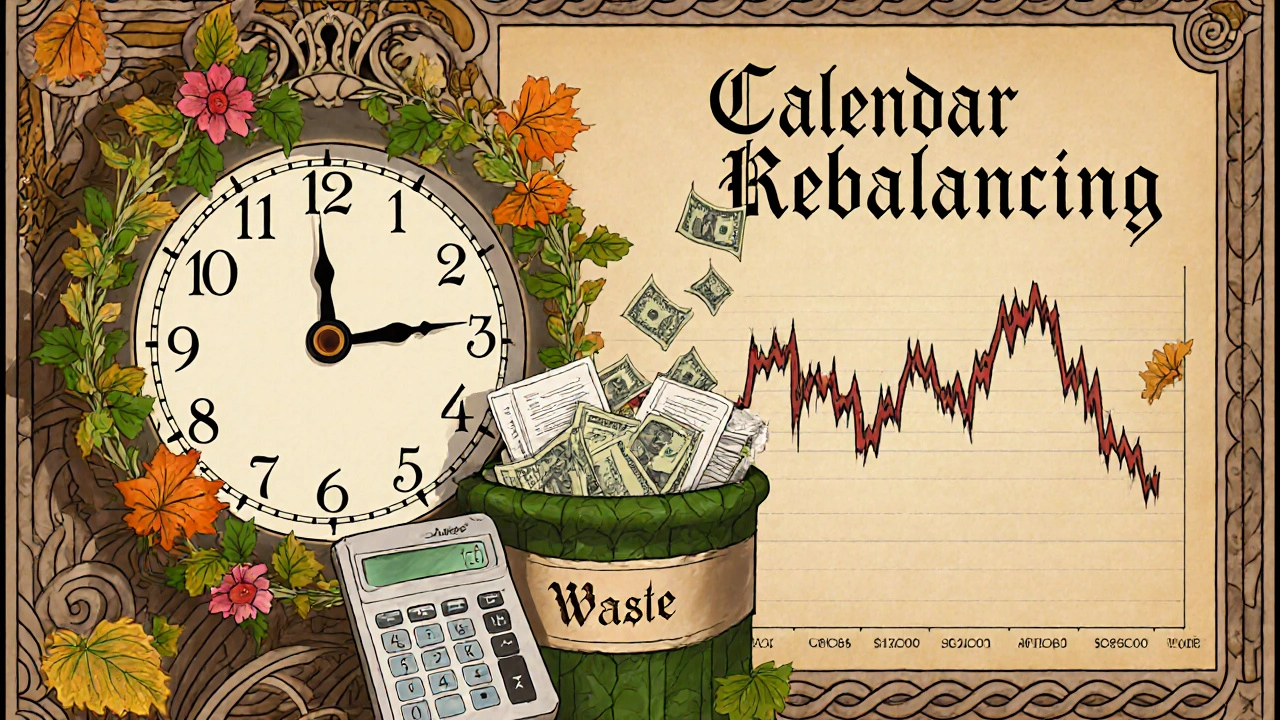Rebalancing Cost Estimator
Your Portfolio
Market Conditions
When you hear "rebalancing," you might think it’s just about selling some stocks and buying others to get back to your target allocation. But what if the way you rebalance is actually hurting your returns? Or worse - what if your strategy looks great on paper but falls apart in real markets? That’s where backtesting rebalancing rules comes in. It’s not about finding the perfect system. It’s about understanding the real cost of discipline - and when that discipline pays off.
Why Most People Get Rebalancing Wrong
A lot of investors rebalance because they’ve been told to. "Buy low, sell high," they say. But in practice, many just do it on a calendar - quarterly, every six months, once a year. Sounds simple. But here’s the problem: markets don’t move on schedules. Sometimes your portfolio drifts 10% off target in three weeks. Other times, it stays within 2% for two years. Rebalancing on a fixed timeline means you’re either acting too early (paying unnecessary fees) or too late (letting risk build up). A 2020 AQR study found that quarterly rebalancing costs 15-20% more in transaction fees than threshold-based rebalancing - and delivers almost the same risk control. That’s not efficiency. That’s waste. And if you’re a retail investor paying $5-$10 per trade, those costs add up fast. Over ten years, that’s hundreds - maybe thousands - of dollars gone for no real benefit. Then there’s the tax angle. Sell an asset that’s gone up, and you trigger capital gains. Do it too often, and you’re handing money to the IRS. Most backtests ignore this. Real investors don’t.Three Ways to Rebalance - And What They Really Do
There are three main methods. Each has tradeoffs. None is perfect.- Calendar-based: Rebalance on a fixed schedule - monthly, quarterly, annually. Pros: Simple. Predictable. Easy to document. Cons: High turnover. You’re forcing trades whether they make sense or not. In a bull market, you’re selling winners too early. In a crash, you’re buying when everyone’s panicking.
- Threshold-based: Rebalance only when an asset moves beyond a set percentage from its target - say, 5% or 7%. Pros: Fewer trades. Lower costs. Less tax impact. Cons: Can lag in trending markets. If tech stocks keep rising, you might wait too long to rebalance and end up with 40% of your portfolio in one sector.
- Hybrid: Combine both. Rebalance quarterly OR when a 6% threshold is hit - whichever comes first. This is what most professional portfolios use. It’s not flashy, but it balances cost control with risk management.
What Metrics Actually Matter (And What Don’t)
Backtesting isn’t about chasing the highest return. It’s about finding the sweet spot between return and risk - and making sure you’re not fooling yourself. Here’s what you need to measure:- Annualized return: Compare it to the S&P 500. If your rebalancing strategy doesn’t at least match the market after fees, why bother?
- Volatility (standard deviation): Lower is better. But don’t confuse low volatility with safety. A portfolio that never moves might be sitting in cash.
- Sharpe ratio: This is the gold standard. It tells you return per unit of risk. Anything above 0.6 is solid. Above 1.0? That’s elite. Most retail backtests show 0.3-0.5 - because they ignore costs.
- Maximum drawdown: How deep did your portfolio fall in its worst period? If your backtest shows a 40% drop during 2008, you’re not ready for real markets.
- Turnover ratio: How often are you buying and selling? A 100% turnover means you replaced your entire portfolio in a year. That’s expensive. Institutional funds average 20-40%. Retail traders often hit 150-200% - and don’t realize why their returns are so low.
- Slippage: The difference between the price you expect and what you actually get. For liquid ETFs, it’s 0.1-0.3% per trade. For small-cap stocks? 1% or more.
- Market impact: If you’re trading $100,000 in a thinly traded stock, your order moves the price. That’s a real loss.
- Taxes: Short-term gains taxed at your income rate? That kills returns. Use tax-loss harvesting. Track cost basis. Don’t just assume your backtest software got it right.

The Backtesting Trap - And How to Avoid It
Here’s the dirty secret: most retail backtests are garbage. A 2023 Reddit survey of 1,200 retail traders found that 72% overestimated returns by at least 30% because they didn’t account for realistic trading costs. One user said their paper-trading strategy showed 12% annual returns. Live trading? 6.5%. That’s not a flaw in the strategy. That’s a flaw in the test. The biggest mistake? Look-ahead bias. That’s when you accidentally use data that wasn’t available at the time. For example, using a stock’s 2020 earnings report to make a 2019 decision. That’s like using today’s weather forecast to plan yesterday’s trip. A 2022 QuantInsti survey found that 41% of retail quants made this error. They used end-of-month data to make end-of-month trades - but the data wasn’t published until days later. That’s not backtesting. That’s cheating. Here’s how to fix it:- Use point-in-time data (like Bloomberg PT or CRSP with date filters).
- Test with a delay - simulate trading with data that’s 1-3 days old.
- Split your data: use 70% to build your strategy, 30% to test it. If it fails on the second half, scrap it.
- Run the same test 100 times with random data. If your strategy still "works," you’ve got a real edge. If not, you just got lucky.
Real-World Results - What Works in Practice
BlackRock’s Sarah Chen used a 5.5% threshold rule with dynamic bands - widening the trigger during high volatility (VIX > 25) and tightening it when markets were calm. Over 15 years, it added 0.47% annualized net of costs. Not huge. But meaningful over decades. Renaissance Technologies’ Medallion Fund, known for its 39.1% annual returns, reportedly uses a proprietary rebalancing system that accounts for 70% turnover. But here’s the key: they don’t just rebalance. They rebalance based on micro-trends, liquidity signals, and order flow - things most retail investors can’t access. For most people, the goal isn’t to beat Medallion. It’s to not lose to the market after fees and taxes. And that’s where simple wins. A 2023 study by Financial Modeling Prep showed that a 5% threshold rebalancing rule, applied quarterly, outperformed monthly rebalancing in 68% of 10-year periods from 1990 to 2020 - even after costs. That’s the sweet spot.
Tools You Can Actually Use
You don’t need a $200,000 data license to start. Here’s what works for most people:- Python + Backtrader: Free. Open-source. Good for beginners. You’ll need to learn basic Python (20-30 hours). It handles slippage and taxes if you code them in.
- QuantConnect: Cloud-based. Better documentation. Handles data feeds automatically. Costs $20/month. Worth it if you’re serious.
- Portfolio Visualizer: No coding. Drag and drop. Great for testing simple rebalancing rules against historical data. Free tier available.
Final Rule: Rebalance to Control Risk - Not to Chase Returns
The goal of rebalancing isn’t to make more money. It’s to not lose more than you should. Markets are unpredictable. Your emotions are worse. Rebalancing is a brake - not an accelerator. If you’re a retail investor, start here:- Use a 5-7% threshold, not a calendar.
- Rebalance only once a year - unless you hit the threshold.
- Use tax-advantaged accounts (IRA, 401k) for rebalancing to avoid taxes.
- Track turnover. If it’s over 30%, you’re doing too much.
- Test your rule against 2008, 2020, and 2022. If it crashes in those years, it’s not robust.
What’s the best rebalancing frequency for a beginner?
For most beginners, annual rebalancing using a 5-7% threshold works best. It’s simple, low-cost, and avoids emotional trading. Don’t start with monthly or weekly rebalancing - the fees and taxes will eat your returns. Stick to one rule, track it for two years, then adjust if needed.
Does rebalancing actually improve returns?
Not always. Rebalancing doesn’t boost returns directly. It improves risk-adjusted returns by reducing volatility and forcing you to sell high and buy low. Studies show it can add 0.3-0.8% annually after costs - but only if you keep fees low and avoid overtrading. In trending markets, it might even hurt performance slightly. The real benefit is psychological: it keeps you disciplined.
Why do institutional investors use threshold-based rebalancing?
Because it’s cost-efficient. Institutional portfolios are large, so even small trading costs add up fast. A 5% threshold reduces turnover by 40-60% compared to calendar-based methods. It also avoids rebalancing during market panics when prices are distorted. Plus, they use dynamic thresholds - widening bands during volatility - which retail investors rarely do.
Can backtesting predict future performance?
No. Backtesting shows how a strategy performed in the past. It doesn’t guarantee future results. Markets change. Liquidity shifts. Regulations evolve. The goal isn’t to find a "winning" backtest - it’s to find a robust one that works across multiple market conditions: bull, bear, high volatility, low volatility. If your strategy only works in 2017-2019, it’s not reliable.
What’s the biggest mistake in rebalancing backtests?
Ignoring transaction costs and taxes. Most free backtesting tools assume zero commissions and no taxes. In reality, even $5 per trade adds up over time. And short-term capital gains can cut your returns in half. Always model realistic costs. Use slippage estimates (0.1-0.3% per trade) and include tax rates based on your income bracket.

Laura W
Okay but let’s be real - if you’re rebalancing quarterly and paying $10 a pop, you’re basically funding your broker’s vacation fund. Threshold-based is the only way to go if you’re not a hedge fund. I’ve been using 7% for my ETF portfolio and my turnover’s down 60%. No more panic-selling when SPY dips 3% for two days. Also, tax-loss harvesting? Do it. Even if it’s just $200 in losses, it offsets gains. Small wins add up.
Also, stop using free tools that ignore slippage. I learned this the hard way - my backtest said 11% returns. Live account? 5.8%. Turned out I was assuming I could buy SPY at the exact close price every time. Lol. Reality’s messier.
Portfolio Visualizer is your friend. Free tier works fine for basic stuff. Just plug in your assets, set your threshold, and let it run. No coding needed. I did this on my phone during lunch. Changed my whole strategy.